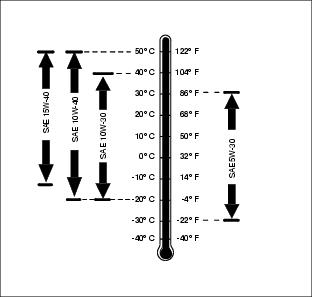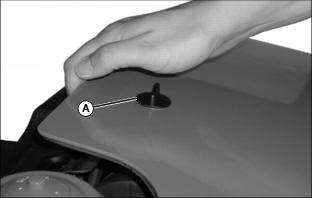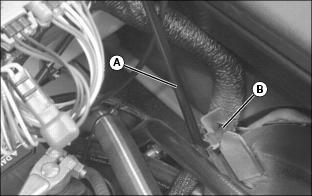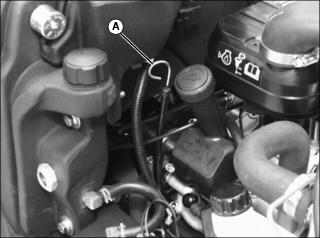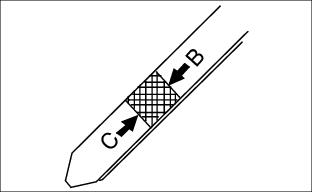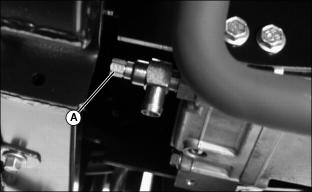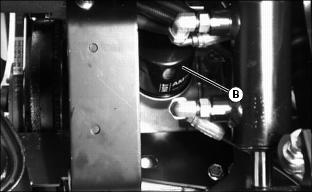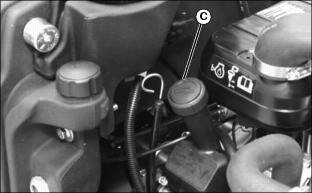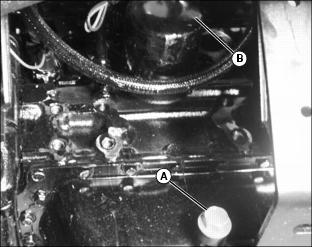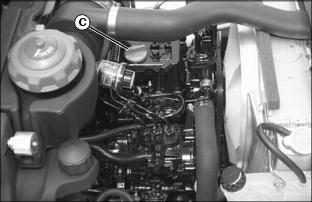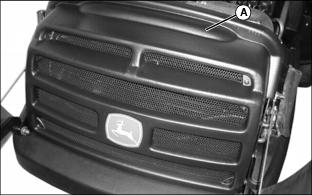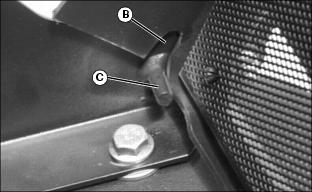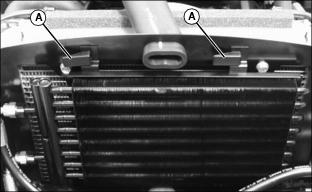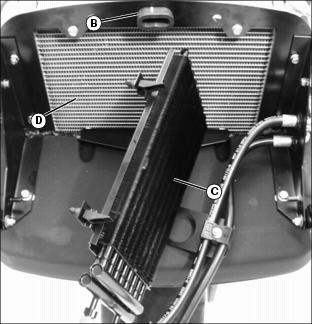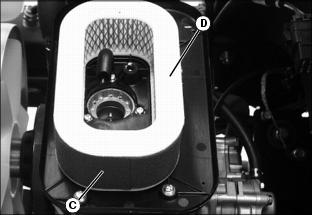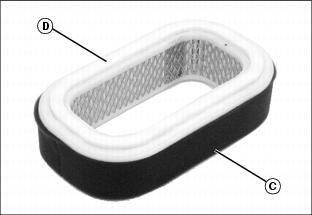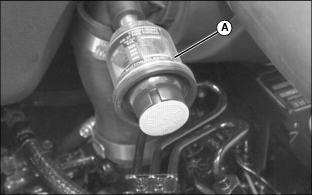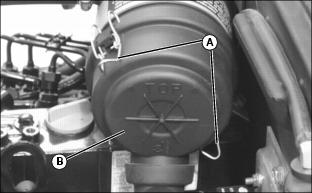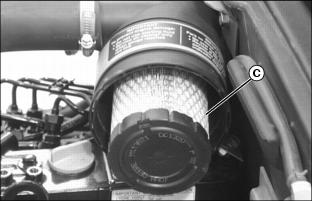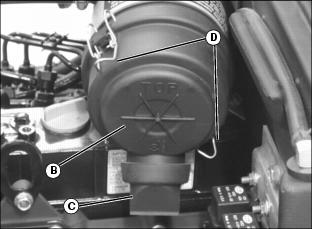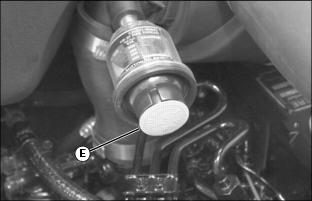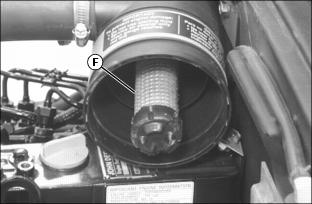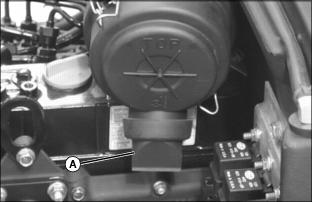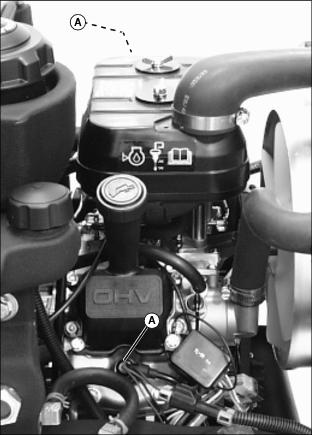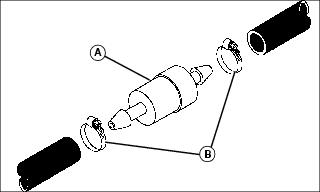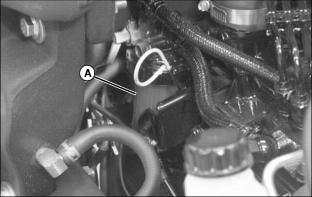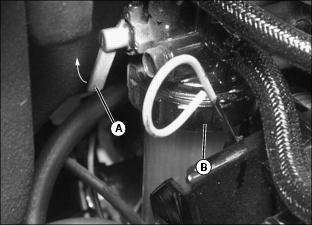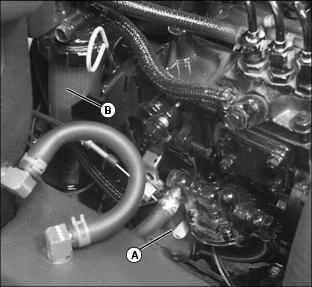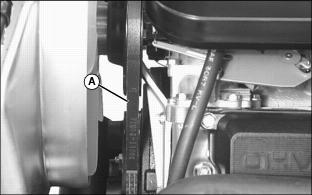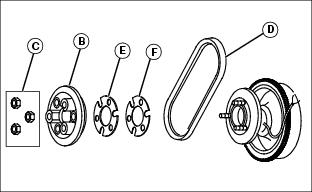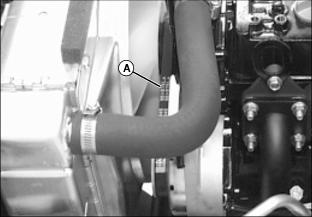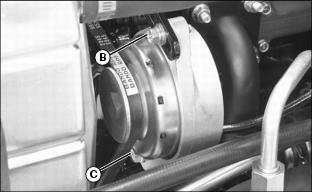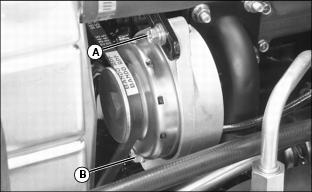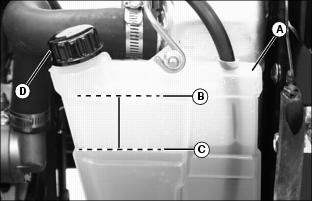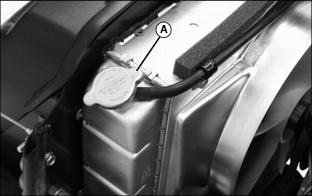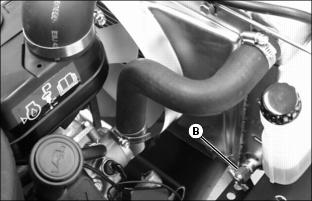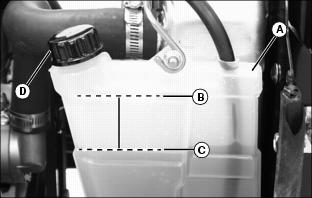
Service Engine
Engine Warranty Maintenance Statement
Maintenance, repair, or replacement of the emission control devices and systems on this engine, which are being done at the customers expense, may be performed by any non-road engine repair establishment or individual. Warranty repairs must be performed by an authorized John Deere dealer.
Avoid Fumes
Engine Oil
Use oil viscosity based on the expected air temperature range during the period between oil changes.
The following John Deere oils are preferred:
· TURF-GARD® (For gasoline engines)
· PLUS-4® (For gasoline and diesel engines)
· PLUS-50® (For diesel engines)
· TORQ-GARD SUPREME® (For diesel engines)
These oils meet the industry specification API Service Classification SJ, CF, or higher.
Raising and Lowering Engine Cowling
1. Park the machine safely. (See Parking Safely in the SAFETY section.)
2. Turn button (A) clockwise to unlock cowling.
4. Lower rear engine cowling to close.
5. Turn button (A) counterclockwise to lock cowling in the lowered position.
Raising and Lowering Operator Seat
Raising the Seat
1. Adjust operator seat rearward as far as possible.
2. Raise and tilt operator seat forward.
3. Remove prop rod (A) secured in stored position under operator seat platform.
4. Install prop rod (A) in channel slot (B).
Lowering the Seat
2. Remove prop rod from channel slot.
3. Secure prop rod in stored position under operator seat platform.
Checking Engine Oil
1. Park the machine safely. (See Parking Safely in the SAFETY section.)
IMPORTANT: Avoid damage! Dirt and contamination can enter engine when checking oil level. Clean area around dipstick before removing. |
Picture Note: Gas engine shown.
3. Remove dipstick (A). Wipe with a clean cloth.
6. Check oil level on dipstick; oil level should be between levels (B) and (C) on the dipstick.
7. If oil is low, add oil to bring oil level no higher than level (B) on the dipstick.
8. If oil level is above level (B) on the dipstick, drain to proper level.
10. Close rear engine cowling.
Changing Engine Oil and Filter (Gas)
1. Run engine to warm the oil.
2. Park the machine safely. (See Parking Safely in the SAFETY section.)
4. Place container under oil drain location.
NOTE: Attaching a section of plastic or rubber hose to the end of drain valve will help prevent engine oil from draining onto the center lift arm.
5. Open drain valve (A) to drain oil.
6. Wipe dirt from around oil filter (B) located under right side of engine.
7. Turn filter counterclockwise to remove.
8. Put a light coat of clean engine oil on the gasket of new filter.
9. Install replacement oil filter by turning to the right (clockwise) until the rubber gasket contacts filter base. Tighten filter an additional one-half turn.
10. Close oil drain valve (A). Do not overtighten.
12. Add approximately 1.8 L (1.9 qt.) of engine oil.
14. Start and run engine at idle to check for leaks. Stop engine. Fix any leaks before operating.
15. Check engine oil level, add oil if necessary.
16. Close rear engine cowling.
Changing Engine Oil and Filter (Diesel)
1. Run engine to warm the oil.
2. Park the machine safely. (See Parking Safely in the SAFETY section.)
4. Place container under oil drain location located under left side of engine.
6. Wipe dirt from around oil filter (B) located under left side of engine.
7. Turn filter counterclockwise to remove.
8. Put a light coat of clean engine oil on the gasket of new filter.
9. Install replacement oil filter by turning to the right (clockwise) until the rubber gasket contacts filter base. Tighten filter an additional one-half turn.
10. Install oil drain plug (A). DO NOT overtighten.
12. Add approximately 2.2 L (2.3 qt.) of engine oil.
14. Start and run engine at idle to check for leaks. Stop engine. Fix any leaks before operating.
15. Check engine oil level, add oil if necessary.
16. Close rear engine cowling.
Cleaning Rear Grille Screen
· Clear work area of bystanders. · Wear eye protection when using compressed air for cleaning purposes. |
IMPORTANT: Avoid damage! Reduced air intake can cause overheating. Keep the rear grille screen clean. |
1. Park the machine safely. (See Parking Safely in the SAFETY section.)
3. Remove rear grille screen (A) from position behind engine radiator.
4. Clean screen with compressed air.
6. Install grille screen notches (B) onto bracket mounting pin (C) at each side.
Cleaning Oil Cooler Coils and Radiator Cooling Fins
· Clear work area of bystanders. · Wear eye protection when using compressed air for cleaning purposes. |
IMPORTANT: Avoid damage! Reduced air intake can cause overheating. Keep hydraulic oil cooler coils and radiator cooling fins clean. |
1. Park the machine safely. (See Parking Safely in the SAFETY section.)
5. Release latches (A) securing oil cooler to the radiator mounting bracket.
6. Carefully move oil cooler away from the radiator.
IMPORTANT: Avoid damage! Engine components may be damaged when cleaning oil cooler coils and radiator fins. Take care to prevent water and debris from entering the air intake hose (B). |
7. Remove dirt and debris from oil cooler coils (C) and radiator fins (D) using compressed air or water.
8. Check oil cooler coils and radiator fins for damage.
11. Close rear engine cowling.
Servicing Air Cleaner Element (Gas)
IMPORTANT: Avoid damage! Dirt and debris can enter the engine when the filter element is removed. Do not run engine without both air cleaner elements installed. |
1. Park the machine safely. (See Parking Safely in the SAFETY section.)
4. Clean any dirt or debris surrounding the air cleaner assembly before removing cover.
5. Remove air cleaner cover (A) by loosening both wing nut bolts (B).
7. Inspect foam precleaner (C) and inside of paper element (D) for dirt and debris without removing it.
8. If foam precleaner is dirty, carefully remove paper filter and precleaner away from the air cleaner housing.
9. Carefully lower air cleaner cover over carburetor opening to keep dirt out of carburetor.
10. Remove foam precleaner (C) from paper element (D).
NOTE: DO NOT wash paper element.
11. Wash precleaner in a solution of warm water and liquid detergent.
12. Rinse precleaner thoroughly. Squeeze out excess water into a dry cloth until precleaner is completely dry.
13. Put approximately 30 ml. (1 oz.) of clean engine oil onto precleaner. Squeeze precleaner to distribute oil evenly. Squeeze out excess oil with a clean cloth.
14. Inspect paper element (D).
15. Replace paper element with a new element only if damaged or very dirty.
16. Install foam precleaner (C) onto new paper element (D).
17. Carefully raise air cleaner cover. Install air cleaner element into air cleaner housing.
18. Install air cleaner cover with wing nut bolts.
19. Close rear engine cowling.
Checking Air Restriction Indicator (Diesel)
1. Park the machine safely. (See Parking Safely in the SAFETY section.)
NOTE: Indicator will not function correctly if plastic indicator housing is damaged.
3. Locate and check air restriction indicator (A).
· When yellow plunger (A) inside indicator is visible inside the green zone, no air cleaner service is required.
· When yellow plunger (A) inside indicator is visible inside the red zone, air cleaner requires immediate service.
Servicing Air Cleaner Element (Diesel)
Servicing Primary Air Filter Element:
1. Park the machine safely. (See Parking Safely in the SAFETY section.)
4. Release latches (A) and remove air cleaner canister cover (B).
5. Remove and discard primary element (C). Replace with a new primary filter element.
6. Install air cleaner canister cover (B) with rubber dust unloading valve (D) pointing downward.
7. Check instruction molded into canister cover for proper installation.
8. Hook latches (A) onto cover.
9. Push reset button (E) on air restriction indicator.
10. Start engine. Allow engine to run approximately one minute at maximum throttle speed.
12. Check air restriction indicator. If yellow plunger inside air restriction indicator is visible inside the red zone, replace secondary air filter element.
Servicing Secondary Air Filter Element:
1. Remove air cleaner canister cover.
2. Remove primary air filter element.
3. Remove and discard secondary air filter element (F). Replace with a new secondary air filter element.
4. Install primary air filter element.
5. Replace air cleaner canister cover.
6. Push reset button on air restriction indicator.
Cleaning Rubber Dust Unloading Valve (Diesel)
IMPORTANT: Avoid damage! Do not operate engine without air cleaner element and rubber dust unloading valve installed. |
1. Park the machine safely. (See Parking Safely in the SAFETY section.)
4. Remove dust unloading valve (A) and clean. Replace if damaged.
5. Install dust unloading valve.
Checking Spark Plugs (Gas)
1. Park the machine safely. (See Parking Safely in the SAFETY section.)
4. Clean area around both spark plugs.
5. Disconnect spark plug wire (A) from each plug.
· Pitted or damaged electrodes.
8. Clean spark plugs carefully with a wire brush.
NOTE: In Canada, replace spark plugs with resistor plugs only.
9. Replace spark plugs as necessary.
10. Check and adjust spark plug gap (B).
· Gap must be 0.7mm (0.028 in.).
11. Install and tighten spark plugs. Tighten plugs to 25 N·m (18 lb-ft).
12. Install both spark plug wires.
13. Close rear engine cowling.
Replacing Fuel Filter (Gas)
1. Park the machine safely. (See Parking Safely in the SAFETY section.)
4. Locate fuel filter on right side of engine.
5. Slide hose clamps (B) away from fuel filter (A).
6. Place a drain pan under hoses to catch any fuel that may be left in the hoses.
7. Disconnect hoses from filter.
NOTE: Make sure fuel filter is installed with arrow pointing in direction of fuel flow toward engine.
9. Connect hoses to new filter.
11. Close rear engine cowling.
Adjusting Carburetor
NOTE: Carburetor is calibrated by the engine manufacturer and is not adjustable.
If engine is operated at altitudes above 1829 m (6,000 ft), some carburetors may require a special high altitude main jet. See your John Deere dealer.
If engine is hard to start or runs rough, check the troubleshooting section of this manual.
Possible engine surging will occur at high throttle with transmission in "N" neutral and mower engagement lever disengaged. This is a normal condition due to the emission control system.
After performing the checks in the troubleshooting section and your engine is still not performing correctly, contact your John Deere dealer.
Servicing Sediment Bowl (Diesel)
1. Park the machine safely. (See Parking Safely in the SAFETY section.)
Checking:
1. Check for water in sediment bowl (A):
· Orange ring will float on top of the water.
2. If necessary, clean bowl and replace filter.
Cleaning:
1. Close fuel shut-off valve (A).
2. Turn collar (B) to remove bowl and filter. Discard filter.
4. Install new filter and bowl.
5. Tighten collar and open fuel shut-off valve.
Using Fuel Pump Primer (Diesel)
NOTE: The fuel pump will need to be primed after the vehicle has completely run out of fuel.
1. Park the machine safely. (See Parking Safely in the SAFETY section.)
3. Check fuel gauge and fill as required.
5. Locate fuel priming lever (A) on left side of engine.
6. Turn the fuel shut-off valve to the "O" (open) position.
7. Pump fuel priming lever until fuel is visible in the fuel filter sediment bowl (B).
NOTE: Fuel system is self bleeding. Crank engine to allow system to bleed itself.
Checking and Adjusting Fan Belt (Gas)
Check Belt Tension
1. Park the machine safely. (See Parking Safely in the SAFETY section.)
4. Inspect fan belt (A) for excessive wear, damage or stretching while in position on the fan and flywheel sheaves.
5. Apply thumb pressure to the belt approximately halfway between the sheaves. Belt should deflect inward approximately 9.5mm (3/8 in.).
Adjust Belt Tension
NOTE: Removal of engine spark plugs will allow for easier rotation of sheave assembly when performing this service procedure.
1. Remove both engine spark plugs.
2. Remove three hex nuts (C) attaching outer half of sheave to the engine flywheel.
3. Remove fan belt (D) if replacement is necessary.
NOTE: To allow sheaves to fit closer together and increase belt tension, remove spacer shim(s). The minimum number installed at the factory is one 0.6mm thick shim (E) and the maximum is two 0.6mm thick shims and one 1.2mm thick shim (F). Removed spacers can be installed between or outside of outer sheave half.
Spacer shim(s) must remain in position when a new belt is installed.
4. Remove spacer shim(s) to increase belt tension.
5. Loosely install belt between sheave halves while installing outer half of sheave onto three threaded flywheel studs.
6. Rotate sheave assembly as nuts are tightened to allow belt to center in sheave halves and not be pinched in an OFF-CENTER position.
7. Tighten nuts to 20-30 N·m (15-21 lb-ft).
8. Apply thumb pressure to the belt approximately halfway between the sheaves. Belt should deflect inward approximately 9.5mm (3/8 in.).
10. Close rear engine cowling.
Checking and Adjusting Alternator Belt (Diesel)
Check Belt Tension:
1. Park the machine safely. (See Parking Safely in the SAFETY section.)
3. Inspect alternator belt (A) for excessive wear, damage or stretching while in position on the fan, alternator and flywheel sheaves.
4. Apply thumb pressure to the belt approximately halfway between the sheaves. Belt should deflect inward approximately 9.5mm (3/8 in.).
Adjusting Belt Tension:
1. Loosen adjustment bolt (B).
2. Loosen alternator mounting bolt (C).
3. Apply outward pressure to the alternator housing.
4. Tighten alternator adjustment bolt and mounting bolt.
5. Apply thumb pressure to the belt approximately halfway between the sheaves. Belt should deflect inward approximately 9.5mm (3/8 in.).
Replacing Alternator Belt (Diesel)
1. Park the machine safely. (See Parking Safely in the SAFETY section.)
4. Loosen alternator adjustment bolt (A).
5. Loosen alternator mounting bolt (B).
6. Apply inward pressure to the alternator housing to loosen belt.
7. Remove worn belt from alternator, fan and flywheel sheaves.
9. Apply outward pressure to the alternator housing to put tension on belt.
10. Tighten alternator adjustment bolt (A) and mounting bolt (B).
11. Apply thumb pressure to the belt approximately halfway between the sheaves. Belt should deflect inward approximately 9.5mm (3/8 in.).
12. Close rear engine cowling.
Service Cooling System Safely
Recommended Engine Coolant
The following John Deere coolants are preferred:
· COOL-GARD® PRE-DILUTED SUMMER COOLANT (TY16036).
· COOL-GARD® CONCENTRATED SUMMER COOLANT (TY16034).
If neither of the recommended coolants is available, use a glycol base coolant that meets the following specification:
Check container label before using to be sure it has the appropriate specifications for your machine. Use coolant with conditioner or add conditioner to coolant before using.
If using concentrate, mix approximately 50 percent antifreeze with 50 percent distilled or deionized water before adding to cooling system. This mixture will provide freeze protection to -37 degrees C (-34 degrees F).
Certain geographical areas may require lower temperature protection. See the label on your antifreeze container or consult your John Deere dealer to obtain the latest information and recommendations. Never exceed the maximum dilution rate for the coolant you are using. Exceeding the maximum rate will greatly reduce the coolant effectiveness.
Checking Radiator Hoses, Air Intake Hose and Hose Clamps
1. Park the machine safely. (See Parking Safely in the SAFETY section.)
4. Check hoses for cracks or damage.
Checking Coolant Level
1. Park the machine safely. (See Parking Safely in the SAFETY section.)
4. Check recovery tank (A) coolant level:
· If engine is warm, coolant level should be between the "H" (HIGH) line (B) and the "L" (LOW) line (C).
· If engine is cold, coolant level should be at the "L" (LOW) line (C) on the recovery tank.
5. Remove recovery tank cap (D) if necessary to add coolant.
6. Add pre-diluted coolant or specified ratio of antifreeze and water.
7. Install and tighten recovery tank cap.
Servicing Cooling System
Draining Cooling System
1. Park the machine safely. (See Parking Safely in the SAFETY section.)
Picture Note: Gas engine shown.
4. Slowly open radiator cap (A) to the first stop to release all pressure.
5. Close radiator cap tightly.
NOTE: A section of plastic or rubber hose can be used to divert fluid away from the greensmower.
Picture Note: Gas engine shown.
6. Open radiator petcock (B). Drain coolant into a pan.
7. When coolant drains from the recovery tank, remove radiator cap.
8. After all coolant has drained, close radiator petcock.
Flushing Cooling System
1. Fill cooling system with clean water and John Deere Cooling System Cleaner, or John Deere Cooling System Quick Flush or an equivalent. Follow directions on the can.
2. Install and tighten radiator cap.
3. Start and run engine until it reaches operating temperature.
6. Drain cooling system immediately before rust and dirt settle.
Filling Cooling System
NOTE: John Deere COOL-GARD coolant is recommended when adding new coolant to the cooling system.
Follow the directions on the container for correct mixture ratio.
2. Fill cooling system. Cooling system capacity is 3.5 L (3.7 qt).
3. Install and tighten radiator cap.
4. Run engine until it reaches operating temperature.
6. Check recovery tank (A) coolant level:
· If engine is warm, coolant level should be between the "H" (HIGH) line (B) and the "L" (LOW) line (C).
· If engine is cold, coolant level should be at the "L" (LOW) line (C) on the recovery tank.
7. Remove cap (D) from recovery tank to add coolant if necessary.
